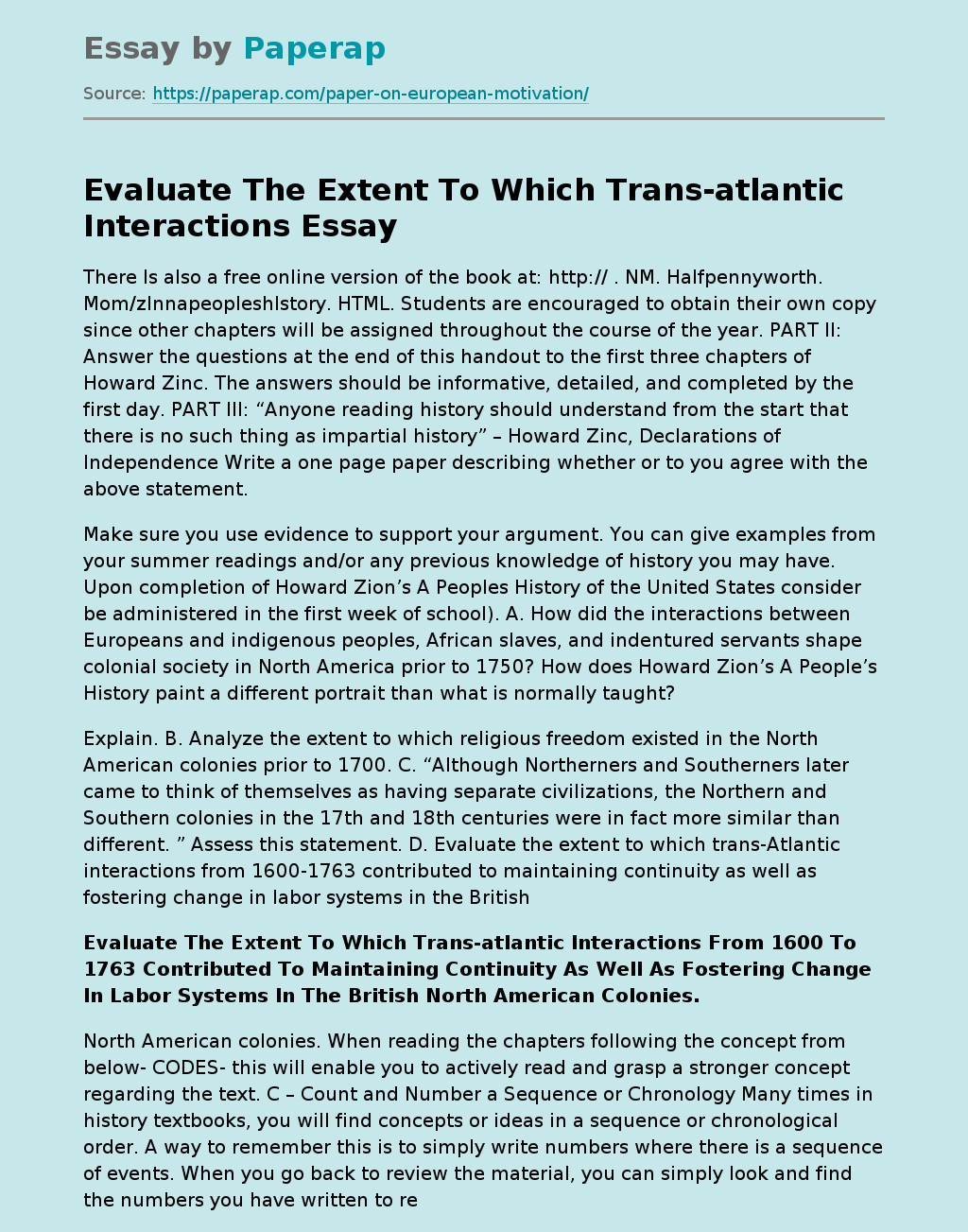Evaluate The Extent To Which Trans-atlantic Interactions
There Is also a free online version of the book at: http:// . NM. Halfpennyworth. Mom/zlnnapeopleshlstory. HTML. Students are encouraged to obtain their own copy since other chapters will be assigned throughout the course of the year. PART II: Answer the questions at the end of this handout to the first three chapters of Howard Zinc. The answers should be informative, detailed, and completed by the first day. PART Ill: “Anyone reading history should understand from the start that there is no such thing as impartial history” – Howard Zinc, Declarations of Independence Write a one page paper describing whether or to you agree with the above statement.
Make sure you use evidence to support your argument. You can give examples from your summer readings and/or any previous knowledge of history you may have. Upon completion of Howard Zion’s A Peoples History of the United States consider be administered in the first week of school). A. How did the interactions between Europeans and indigenous peoples, African slaves, and indentured servants shape colonial society in North America prior to 1750? How does Howard Zion’s A People’s History paint a different portrait than what is normally taught?
Explain. B. Analyze the extent to which religious freedom existed in the North American colonies prior to 1700. C. “Although Northerners and Southerners later came to think of themselves as having separate civilizations, the Northern and Southern colonies in the 17th and 18th centuries were in fact more similar than different. ” Assess this statement. D. Evaluate the extent to which trans-Atlantic interactions from 1600-1763 contributed to maintaining continuity as well as fostering change in labor systems in the British
Evaluate The Extent To Which Trans-atlantic Interactions From 1600 To 1763 Contributed To Maintaining Continuity As Well As Fostering Change In Labor Systems In The British North American Colonies.
North American colonies. When reading the chapters following the concept from below- CODES- this will enable you to actively read and grasp a stronger concept regarding the text. C – Count and Number a Sequence or Chronology Many times in history textbooks, you will find concepts or ideas in a sequence or chronological order. A way to remember this is to simply write numbers where there is a sequence of events. When you go back to review the material, you can simply look and find the numbers you have written to review the chorological order.
After you eve the chronological time-frame down, you can concentrate on the key details and other concepts. 0= Circle Important Vocabulary, Names & Places Also in history textbooks, there are many vocabulary terms, names of people to know and places to remember. An easy way to annotate this concept is to circle these items. Clearly, one should look up vocabulary terms, research the person was and how they were significant and the significance of the places as well, but in an initial annotation of the textbook, this is a good way to identify these items first. D= Decide and Underline Key Details
Many students develop techniques of underlining key details to identify the information they need to remember. This can be a very helpful technique, but one should limit the amount of underlining that is done. Too much underlining is worse than none, since it defeats the purpose, which is to clearly mark those items in a book or secondary reading that you think are important to remember. E= Emphasize the Most Important Ideas Identifying the most important ideas and points are also what history is about. In reading, you need to know what the “big picture” ideas and concepts are as well as, he main ideas within the chapter.
Once you have identified the most important ideas, you can then back up this with key details. S= Summarize In Your Own Words truly shows your understanding. When you summarize articles or portions of chapter in your textbook, you are synthesizing information, and demonstrating your understanding of the material. This can be done on an open space or area in the article, or if you are summarizing the text, you can summarize in a section of your notebook. Wherever you have your summaries, this is the last step in the annotated process.
Evaluate The Extent To Which Trans-atlantic Interactions. (2019, Dec 05). Retrieved from https://paperap.com/paper-on-european-motivation/
